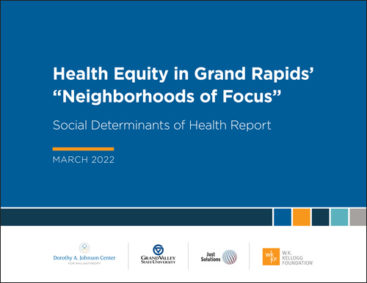Supporting Health Equity in Michigan Communities


The environmental, economic, and social factors that influence our health are commonly referred to as social determinants of health. These factors are beyond our personal control and are experienced uniquely and often unequally, shaping health care encounters, and contributing to health inequities. Achieving and maintaining good health is the consequence of these life factors and influences.
 In 2022, the Johnson Center’s Community Data and Research Lab and Just Solutions released the Health Equity in Grand Rapids’ “Neighborhoods of Focus” Social Determinants of Health Report with support from the W.K. Kellogg Foundation. This report investigated the social determinants of health disparities in 17 census tracts in Grand Rapids, Michigan, deemed “Neighborhoods of Focus” (NOF) following research that located the areas with higher rates of poverty, unemployment, and housing cost burden and lower rates of educational attainment than elsewhere in the city. The results provided a baseline of health factors and conditions for children and families in the NOF prior to the COVID-19 pandemic.
In 2022, the Johnson Center’s Community Data and Research Lab and Just Solutions released the Health Equity in Grand Rapids’ “Neighborhoods of Focus” Social Determinants of Health Report with support from the W.K. Kellogg Foundation. This report investigated the social determinants of health disparities in 17 census tracts in Grand Rapids, Michigan, deemed “Neighborhoods of Focus” (NOF) following research that located the areas with higher rates of poverty, unemployment, and housing cost burden and lower rates of educational attainment than elsewhere in the city. The results provided a baseline of health factors and conditions for children and families in the NOF prior to the COVID-19 pandemic.
To learn more about how the report’s data are being used for community conversations and action aimed at moving away from disparity and toward equitable opportunity and health, we spoke with Melanie Wong, M.A., RDN, Farm to Early Care and Education Specialist at Groundwork Center for Resilient Communities. Groundwork has offices in Traverse City and Petoskey; Melanie works remotely from Grand Rapids. Since its beginning in 1995 as the Michigan Land Use Institute, the organization has given people opportunities to create a better Michigan with innovative, local-based solutions that protect the environment, strengthen the economy, and build thriving communities. Groundwork is the communications and outreach partner working with the Michigan Department of Education to help implement 10 Cents a Meal for Michigan’s Kids & Farms across the state.
 Melanie Wong: In Grand Rapids, Groundwork’s role in promoting health and racial equity is focused on education and expansion of 10 Cents a Meal, a state-funded program that matches what schools, early care and education centers, and other organizations participating in the U.S. Department of Agriculture Child Nutrition programs spend on Michigan-grown fruits, vegetables, and legumes with grants matching up to 10 cents per meal. For 2022-2023, the statewide program has a budget of $9.3 million to support purchases of Michigan-grown produce that help improve daily nutrition and eating habits for children in school and childcare settings and build Michigan’s local food economy.
Melanie Wong: In Grand Rapids, Groundwork’s role in promoting health and racial equity is focused on education and expansion of 10 Cents a Meal, a state-funded program that matches what schools, early care and education centers, and other organizations participating in the U.S. Department of Agriculture Child Nutrition programs spend on Michigan-grown fruits, vegetables, and legumes with grants matching up to 10 cents per meal. For 2022-2023, the statewide program has a budget of $9.3 million to support purchases of Michigan-grown produce that help improve daily nutrition and eating habits for children in school and childcare settings and build Michigan’s local food economy.
The program supports health equity by helping food service directors purchase and serve more fresh, minimally processed Michigan-grown produce instead of canned. 10 Cents a Meal also has educational and marketing components that aim to promote Michigan-grown produce and food, nutrition, and agricultural education opportunities. Grantees have a wide variety of plans that range from hanging promotional posters that feature local fruits and vegetables to hosting taste tests highlighting different fruits, vegetables, or legumes. Whatever the educational activities offered, the goal is to help expand children’s view of food and where it comes from, while supporting the formation of healthy eating habits.
The Social Determinants of Health report highlighted that access to grocery stores in some parts of the NOF is limited. Providing meals with fruits and vegetables for children in school or childcare can be a source of crucial nutrients to support their health, development, and learning readiness. The financial incentive provided to 10 Cents a Meal grantees can also help offset food costs for food service directors interested in trying different varieties of produce to expose children to new flavors, textures, and tastes as a learning opportunity.
Melanie: The data on two social determinants of health indicators, Access to Healthy Food and Nutrition, and Access to Quality Education, were of high interest for our work on 10 Cents a Meal. The information in the “Making the Connection” section of the report also helped us understand the interconnectedness of these two indicators and how they are related to health disparities.
Melanie: As the communication and outreach partner for 10 Cents a Meal, this data is crucial information for our outreach plan. We aim to increase participation in 10 Cents a Meal in the Grand Rapids region by making connections and supporting local school districts and early care and education centers to become 10 Cents a Meal grantees.
Melanie: The data in the report affirm the need for increased access to healthy food by highlighting inequities within the NOF community. It is evident that 10 Cents a Meal has an opportunity to serve these communities and act as a policy-based solution making a direct impact on the children living in the area. The fact that 85% of children who attended a school in the NOF came from households with incomes eligible for free/reduced-price lunch was very telling. Schools are often the biggest restaurants within communities, feeding children up to half of their daily calories according to the Centers for Disease Control and Prevention.
10 Cents a Meal is a tool to increase access to healthy foods for children within the city, and the data presented support that strategy. We’d really like to help more local school districts and early care and education centers participate in 10 Cents a Meal so they can increase their purchasing power for healthy, Michigan-grown produce. Michigan is the second most agriculturally diverse state in our country, and many Michigan-grown products — like sliced apples — are already being utilized in Michigan school food service operations. By participating in 10 Cents a Meal, any minimally processed Michigan-grown produce already utilized by local school districts and early care and education centers would be eligible for 10 Cents a Meal funds. That influx of money would positively affect their food service budget!
Since serving fruits and vegetables are required by USDA nutrition standards for child food programs, the district is already making a positive impact on feeding children. That impact could be increased if they participated in 10 Cents a Meal and used those funds to help support their meal program and integrate farm-to-school strategies to enrich the whole child.
Melanie: We are working on a research project in partnership with Professor Daniela Marini and graduate students at Grand Valley State University’s Social Innovation Program to assess the food landscape in select NOFs identified in the report. The project will explore how 10 Cents a Meal can be a part of the solution to increase access to healthy foods for children across these communities based on the unique resources and challenges each community has.